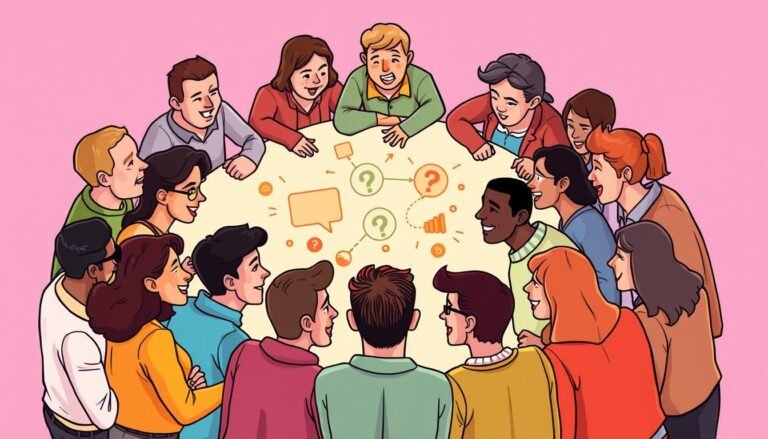The Art of Workplace Communication: Psychological Tactics for Leaders
Are you ready to unlock the secret weapon of top business leaders? In today’s fast-paced work environment, effective workplace communication is key. It’s the foundation of successful leadership and keeping employees engaged. But how can leaders use communication to inspire and motivate their teams?
Leadership communication is more than just talking. It’s an art that blends psychology, strategy, and empathy. When done well, it turns ordinary teams into high-performing ones. Leaders who communicate well have more engaged, productive, and loyal employees.
Imagine a workplace where ideas flow freely and everyone feels heard. That’s what effective leadership communication can create. It’s not just about giving orders or sharing information. It’s about building connections, understanding, and inspiring action.
In this article, we’ll look at the psychological tactics that make great communicators stand out. We’ll explore strategies for clearly sharing your vision, building rapport, and encouraging teamwork. Whether you’re an experienced executive or an aspiring leader, these tips will help you improve your communication skills and drive success in your organization.
Key Takeaways
- Clear communication boosts job satisfaction and morale
- Strong communicators lead more efficient teams
- Empathetic communication increases employee engagement
- Transparent leadership builds trust and loyalty
- Active listening improves team productivity
- Nonverbal cues significantly impact communication effectiveness
- Trust enhances receptiveness to leadership messages
Understanding the Importance of Effective Leadership Communication
Leadership communication is key to a successful workplace. It keeps teams together, boosts productivity, and shapes the company’s culture. Leaders who communicate well inspire and motivate their team to do their best.
Defining Leadership Communication in the Workplace
Leadership communication is more than just talking. It’s about sharing a vision, giving clear directions, and encouraging open talks. Great leaders connect with their team on both work and personal levels.
Impact of Strong Communication on Employee Engagement
Good communication affects the whole company. It makes employees feel connected to their work and the company’s goals. This leads to better productivity, innovation, and happiness at work. In fact, studies show companies with strong communication have 50% less employee turnover.
The Role of Communication in Building Trust and Rapport
Trust is essential for a successful team. Leaders build trust through consistent and open communication. This trust creates a positive work environment where everyone can share ideas and work together well.
“The art of communication is the language of leadership.” – James Humes
By focusing on clear communication, building strong relationships, and creating a positive work culture, leaders can make their workplace better. This approach improves morale and helps the company reach its goals with a united team.
The Psychology Behind Influential Communication
Leadership communication is all about understanding people. Good leaders know that building strong relationships and team success starts with how we talk to each other. If we don’t communicate well, we can get lost in misunderstandings and conflicts.
Social Identity Theory is key in the workplace. It says we identify with groups and feel good about who we are because of them. Leaders who get this can talk to their team in ways that really connect with them.
Being mindful in how we communicate makes our team happier. Mindful leaders observe without judgment, creating a positive work space. This makes everyone feel valued and respected.
“Adopting specific talking habits can have a transformative effect on various aspects of life and relationships.” – Gerald Goodman, Ph.D.
Leaders also know the value of silence. Using pauses, or “conversational allowing,” lets everyone think and understand better. This skill makes our interactions with the team more meaningful.
| Communication Aspect | Impact on Leadership |
|---|---|
| Mindful Communication | Increased follower satisfaction |
| Strategic Silence | Enhanced understanding and reflection |
| Gradual Disclosure | Built trust and intimacy |
| Empathetic Listening | Improved problem-solving |
Mastering Verbal Communication Strategies
Leadership communication skills are key for success at work. Good messaging can make a big difference in team performance. Let’s look at important strategies for improving verbal communication at work.
Clear and Concise Language
Leaders should use simple words to explain complex ideas. This ensures everyone gets the message. Research shows that 52% of employees feel stressed because of bad communication at work.
By speaking clearly, leaders can lower stress and increase productivity.
Adapting to Different Audiences
Effective messaging means adjusting how you communicate. Some team members like detailed written instructions, while others prefer quick verbal directions. Knowing these differences is crucial for good leadership communication.
Persuasive Speaking Techniques
Leaders can motivate their teams with persuasive speaking. They use stories to make data relatable and metaphors to highlight important points. This way, leaders make information more meaningful and help team members understand better.
“Good communication is the bridge between confusion and clarity.” – Nat Turner
Improving verbal communication skills takes practice. Great communicators get better over time with effort and refining their methods. By mastering these strategies, leaders can greatly improve their effectiveness and help their teams succeed.
Harnessing the Power of Non-Verbal Communication
Non-verbal communication is key to being a good leader. It can make up to 55% of what we communicate. This means it’s very important for showing feelings, attitudes, and what we plan to do. Leaders who get this right can really inspire and motivate their teams.
Being good at non-verbal communication starts with strong interpersonal skills. Leaders need to work on their body language, facial expressions, and voice. Also, being an active listener is crucial. It helps leaders connect better with their team.
To get better at non-verbal communication, leaders can:
- Practice power posing to boost confidence
- Mirror and match body language to establish rapport
- Engage in wholehearted listening to foster genuine connections
- Use video analysis and journaling for self-awareness
- Employ mindfulness meditation to enhance presence
Knowing about different cultures is important in global business. Adapting how we communicate non-verbally to fit cultural norms helps a lot. By learning these skills, leaders can improve how they communicate and strengthen team relationships.
| Non-Verbal Cue | Impact on Leadership Communication |
|---|---|
| Eye Contact | Demonstrates authority and confidence |
| Firm Handshake | Conveys professionalism and trustworthiness |
| Straight Posture | Projects confidence and competence |
| Genuine Smile | Builds rapport and approachability |
Workplace Communication: Tactics for Fostering Collaboration
Good communication is key for teamwork and success in the workplace. Leaders today must focus on open talks and feedback. Studies reveal that bad communication costs U.S. businesses $1.2 trillion each year. This shows we need better ways to talk and work together.
Creating Open Channels for Feedback
It’s important to have clear ways to talk in the workplace. Companies can use anonymous surveys or regular meetings to get everyone’s thoughts. This makes employees feel important and boosts their work.
Facilitating Effective Team Meetings
Good team meetings are crucial for teamwork. Having clear plans, letting everyone speak, and checking on tasks can make teams work better. Tools like Slack help keep everyone in the loop.
Encouraging Cross-Departmental Communication
It’s important to get different teams to work together. This helps break down barriers and makes the whole company better. By doing projects together and having events, teams can share ideas and grow.
Using these strategies can really help improve how we talk and work together. Companies that do well in communication are 3.5 times more likely to beat their rivals. This shows how vital these methods are in today’s business world.
| Communication Strategy | Impact on Workplace |
|---|---|
| Open Feedback Channels | Increased employee engagement |
| Effective Team Meetings | Improved project success rates |
| Cross-Departmental Collaboration | Enhanced innovation and productivity |
Leveraging Technology for Enhanced Communication
In today’s digital world, how we talk at work has changed a lot. Tools for working together have made team talks better. These tools, like video calls and project management software, are changing how we communicate at work.
Email is still key for work chats, with people getting 122 emails a day. But only 38% of these are really important. Video calls are becoming a big help, making teams 30% more productive, a study found.
More companies are using AI tools to work better. In 2022, 35% of businesses started using AI, saving time and money. IBM saw its projects finish 25% faster with AI.
But, there are still problems. A study showed 86% of workers say bad communication and teamwork lead to failures. To fix this, companies are trying new things:
- Online forms for easier data collection
- Platforms for sharing ideas and working together
- AI chatbots for quick customer help
Using these tech tools can make work better and more connected. But, it’s important to remember that people are key too. Tech should help, not replace, the human touch in work talks.
| Communication Tool | Key Benefit | Usage Statistic |
|---|---|---|
| Widespread adoption | Most used business communication tool globally | |
| Video Conferencing | Real-time interaction | 30% boost in team productivity |
| AI-powered Tools | Improved efficiency | 25% reduction in project completion time |
Overcoming Communication Barriers in Diverse Teams
Diverse teams face unique communication challenges. Cultural differences, age gaps, and different ways of talking can block teamwork and company culture. Leaders must find ways to include everyone and keep communication flowing well.
Addressing Cultural Differences
Cultural diversity changes how we communicate. Some cultures like to talk indirectly, while others prefer straight talk. Knowing these differences helps avoid mistakes and strengthens team bonds.
Managing Generational Gaps
Each generation has its own way of communicating. Baby Boomers like talking face-to-face, while younger folks prefer digital. Leaders can use both methods to make sure everyone feels heard and involved.
Fostering Inclusive Communication
It’s important to make sure everyone’s voice is heard. This means:
- Encouraging open dialogue
- Actively seeking input from all team members
- Using inclusive language
- Providing equal chances to join in meetings and projects
By tackling these issues, leaders can make teams work better together. Good communication in diverse teams not only boosts teamwork but also makes the company culture better by valuing diversity.
| Communication Barrier | Impact | Solution |
|---|---|---|
| Language differences | Misunderstandings, delays | Language training, translators |
| Cultural norms | Conflicts, discomfort | Cultural sensitivity training |
| Generational preferences | Disconnected teams | Multi-channel communication |
| Exclusive practices | Reduced engagement | Inclusive policies, diverse representation |
The Role of Emotional Intelligence in Leadership Communication
Emotional intelligence is crucial for leaders. It helps them understand their feelings and those of others. This leads to better communication skills.
Studies show that 71% of employers value emotional intelligence more than technical skills. This is because it predicts workplace success.
Leaders with high emotional intelligence excel in communication. They can adapt to different styles and manage their emotions. This creates a positive work environment and encourages teamwork.
“Respectful treatment of all employees at all levels” is the top factor in job satisfaction for 72% of employees.
Emotionally intelligent leaders do better in their roles. They make better decisions, manage teams well, and solve conflicts. Empathy, for example, boosts job performance by over 40%.
Companies can improve emotional intelligence through training. Workshops and coaching focus on emotional awareness and communication. Investing in these skills boosts leadership and overall success.
Crafting and Delivering Impactful Messages
Effective messaging is key for leaders. They can inspire their teams to do great things by telling compelling stories. Let’s look at how to make messages that really connect and motivate.
Structuring Compelling Narratives
A good story grabs your attention and makes complex ideas simple. Leaders should focus on three main parts:
- Clear purpose
- Relatable characters
- Engaging plot
By combining these, leaders can make messages that people remember long after they hear them.
Using Storytelling to Inspire
Storytelling is a strong tool for leaders. It makes hard-to-understand ideas clear and easy to remember. Here are some tips for storytelling:
- Use vivid imagery
- Create emotional connections
- Highlight personal experiences
Tailoring Messages for Different Channels
Messages need to fit the channel they’re sent through. Leaders should know the good and bad of each way to communicate. Here’s a look at different channels:
| Channel | Strengths | Limitations |
|---|---|---|
| Detailed information, documentation | Lack of immediate feedback | |
| Video calls | Visual cues, real-time interaction | Technical issues, fatigue |
| In-person meetings | Non-verbal communication, rapport building | Scheduling challenges, limited reach |
By getting better at messaging, leaders can improve their communication. This helps them make real changes in their teams.
Measuring and Improving Communication Effectiveness
Workplace communication is key to keeping employees engaged. Yet, it’s hard to measure its success. A 2022 Gallagher report found that not having analytics is a big problem for communication teams.
Leaders need to use strong feedback tools to see how well their plans work. This helps them understand what’s working and what’s not.
Success in communication means looking at different numbers. These include how many messages are sent, opened, and clicked on. It also means seeing if people are changing their behavior and if it’s helping the business.
Surveys, focus groups, and online discussions are great for getting feedback. They help leaders know if their communication is effective.
A 2023 Gallagher report shows some progress. Now, 63% of top business leaders check if their messages are reaching people. But, only 52% show how well internal communication works to leaders. This shows we need better ways to measure communication.
To make communication better, leaders should keep learning and growing. They should always check their methods and change them based on what employees say. Remember, good communication is always getting better and needs constant effort.
Source Links
- Why communication is essential to effective leadership
- 8 Ways You Can Improve Your Communication Skills – Professional & Executive Development | Harvard DCE
- The Role of Communication in Leadership
- Council Post: The Power Of Effective Communication In Leadership
- Communication is Key
- What is the Importance of Communication in Psychology? | Saybrook
- Mindfulness and Leadership: Communication as a Behavioral Correlate of Leader Mindfulness and Its Effect on Follower Satisfaction
- 6 Steps To Improving Verbal Communication | Chanty
- 8 Effective Verbal Communication Techniques for Professional Success
- Mastering Effective Communication for Career Advancement
- Harnessing the Power of Nonverbal Communication in Business
- Harness the Power of Non-Verbal Communication – Morgan Samuels
- How to harness the silent power of nonverbal communication
- Tips for Effective Communication in the Workplace
- 10 Effective Communication Strategies In The Workplace | Radical Candor
- Strategies for Fostering Collaboration and Communication in the Workplace
- How to Leverage Technology for Effective Employee Communication and Collaboration
- Leveraging Technology for Better Communication
- Overcoming Communication Barriers: Enhancing Workplace Engagement
- How To Overcome The Top 4 Communication Barriers In The Workplace | Talaera
- How can you overcome communication barriers in diverse teams?
- Emotional Intelligence in Leadership: Why It’s Important
- The Crucial Role of Emotional Intelligence and Empathy in Modern Leadership
- The Role of Emotional Intelligence in Effective Leadership Communication
- Crafting Effective Communication: Key Characteristics and Strategies for Success!
- Crafting Memorable Internal Communication Messages
- How To Measure Communication Effectiveness With The Right Metrics
- How to Measure Communication Effectiveness: Best Metrics and KPIs







